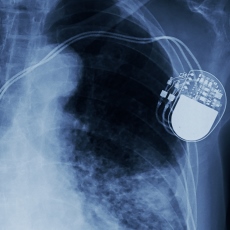An implantable cardioverter-defibrillator (ICD) or automated implantable cardioverter defibrillator (AICD) is a device implantableinside the body, able to perform cardioversion, defibrillation, and (in modern versions) pacing of the heart. The device is therefore capable of correcting most life-threatening cardiac arrhythmias. The ICD is the first-line treatment and prophylactic therapy for patients at risk for sudden cardiac death due to ventricular fibrillation and ventricular tachycardia. Current devices can be programmed to detect abnormal heart rhythms and deliver therapy via programmable antitachycardia pacing in addition to low-energy and high-energy shocks.

“AICD” was trademarked by the Boston Scientific corporation, so the more generic “ICD” is preferred terminology.
Current device batteries last about 6–10 years, With advances in the technology (batteries with more capacity or, potentially in the future with rechargeable batteries [2][3]) it may be possible to increase this well past 10 years. The lead (the electrical cable connecting the device to the heart) has a much longer average longevity but can incur various types of malfunction, specifically insulation failure or fracture of the conductor and require replacement.
The process of implantation of an ICD system is similar to implantation of a pacemaker. In fact, ICDs are composed of an ICD generator and of wires. The first component or generator, contains a computer chip or circuitry with RAM (memory), programmable software, a capacitor and a battery; this is implanted typically under the skin in the left upper chest. The second part of the system is an electrode wire or wires that, similar to pacemakers, are connected to the generator and passed through a vein to the right chambers of the heart. The lead usually lodges in the apex or septum of the right ventricle. Just like pacemakers, ICDs can have a single wire or lead in the heart (in the right ventricle, single chamber ICD), two leads (in the right atrium and right ventricle, dual chamber ICD) or three leads (biventricular ICD, one in the right atrium, one in the right ventricle and one on the outer wall of the left ventricle). The difference between pacemakers and ICDs is that pacemakers are also available as temporary units and are generally designed to correct slow heart rates, i.e. bradycardia, while ICDs are often permanent safeguards against sudden life-threatening arrhythmias.
To Get An Appointment Today (+91) 9607799333

